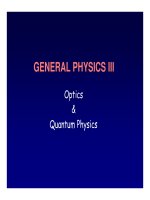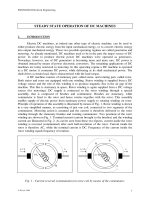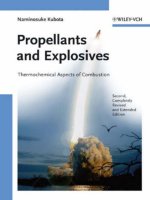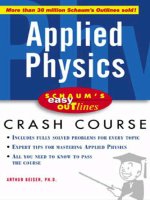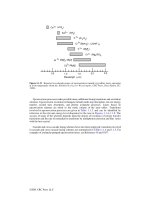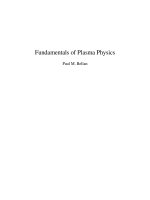- Trang chủ >>
- Khoa Học Tự Nhiên >>
- Vật lý
Relativistic Aspects of Nuclear Physics ppt
Bạn đang xem bản rút gọn của tài liệu. Xem và tải ngay bản đầy đủ của tài liệu tại đây (30.38 MB, 478 trang )
Proceedings of the Sixth International Workshop on
\t\elativistic rfAspects
/\pclear (L/hysics
ii *
Editors
*"*»".
v '«,
T. Kodama
C. E. Aguiar ^ \
H T. Elze
F. Grassi
YHama ;^ ;*£
G. Krein ^
|^-i
World Scientific
Proceedings of the Sixth International Workshop on
Relativistic
Aspects
of
Nuclear Physics Proceedings
of
the Sixth International Workshop
on
Relativistic Aspects
of
Nuclear Physics
Caraguatatuba, Sao Paulo, Brazil 17-20 October 2000
Editors
Takeshi Kodama
Carlos Eduardo Aguiar
Hans Thomas Elze
Federal University
of
Rio de Janeiro, Brazil
Frederique Grassi and Yogiro Hama
University
of
Sao Paulo, Brazil
Gastao Krein
State University
of
Sao Paulo, Brazil
V|b World Scientific
wb Singapore • New Jersey London
•
Singapore • New Jersey 'London
•
Hong Kong
Published by
World Scientific Publishing Co. Pte. Ltd.
P O Box 128, Farrer Road, Singapore 912805
USA office: Suite IB, 1060 Main Street, River Edge, NJ 07661
UK office: 57 Shelton Street, Covent Garden, London WC2H 9HE
British Library Cataioguing-in-Publication Data
A catalogue record for this book is available from the British Library.
RELATIVISTIC ASPECTS OF NUCLEAR PHYSICS
RANP2000
Copyright © 2001 by World Scientific Publishing Co. Pte. Ltd.
All rights
reserved.
This book or parts
thereof,
may not be reproduced in any form or by any means,
electronic or mechanical, including photocopying, recording or any information storage and retrieval
system now known or to be
invented,
without written permission from the Publisher.
For photocopying of material in this volume, please pay a copying fee through the Copyright
Clearance Center, Inc., 222 Rosewood Drive, Danvers, MA 01923, USA. In this case permission to
photocopy is not required from the publisher.
ISBN 981-02-4715-X
Printed in Singapore by Uto-Print
Y*9
* '
.
.A* ""Sw
s.™
'"•W**"-*^,
m-
:
-
•••
*'•
v
.•II
VII
PREFACE
It
is our
pleasure
to
present
the
Proceedings
of the VI
International Work-
shop
on
Relativistic Aspects
of
Nuclear Physics (RANP 2000). This time,
the meeting took place
in
Tabatinga,
a
pleasant beach
on the
southern coast
of Brazil,
for the
first time
out of the
city
of Rio de
Janeiro. This series
of
workshops started
in 1989,
aiming
to
stimulate Brazilian scientific activities
on
Relativistic Nuclear Physics, especially among young researchers
and
graduate
students.
The VI
Workshop, held
in
October 2000, reflected
the
excitement cre-
ated
in the
field
by the
start
of
operations
of
Brookhaven's Relativistic Heavy
Ion Collider just four months earlier,
in
June.
The new
frontiers
of
investiga-
tion opened
by
RHIC, among other topics, were actively discussed
by the 100
participants
of the
Workshop, which came from
all
parts
of
Brazil
and
abroad.
RANP 2000 kept
the
format
of the
previous meetings, somewhat
in the way
between
a
specialist's workshop
and an
advanced graduate school.
The
invited
speakers
did a
remarkable
job in
presenting
the
most recent
and
important
de-
velopments
in
Relativistic Nuclear Physics
in a
didactical manner. They have
also kindly contributed
the
manuscripts which form part
of
this volume. Mem-
bers
of the
organizing committee express their sincere thanks
to
those invited
speakers
who
always warmly contributed
to the
success
of the
meeting.
In ad-
dition, many interesting contributed papers were presented
in a
poster session
which
are
also included
in the
book. Note that
the
number
of
contributed works
increased steadily
and
this time
we had
more than twice compared
to the
earlier
meetings
of
this series.
We are
happy
for
this fact which shows
the
growth
of
the young researchers
of the
area
in
Brazil.
It
is
worth
to
mention that
we had a
really exciting round-table debate
entitled,
"QGP -
Observed
or not yet
observed
?
That
is the
question."
In
spite
of
the
hottest discussion
on a
very controversial subject
at the
moment,
the
discussion leader transformed skillfully
the
fatal collision into
a
Happy-Hour,
by
the
help
of
lubricating fluid, called "caipirinha".
We
regret that
we
failed
to
record this historically interesting debate.
As usual,
Ms.
Dilza Barros again helped
us the
organization
as
Conference
Secretary.
We
thank
her
dedication
and
professional work.
The
organization
of RANP 2000
was
supported from several Institutions
to
which
we
would like
to express
our
thanks: CNPq, FAPESP, FAPERJ, CAPES, CLAF, PRONEX,
CBPF,
UFRJ, UERJ.
On April
the
22nd
of
this year
in
Tokyo,
Prof.
Mituo Taketani deceased.
He
was
not
only
one of the
great leaders
of
modern Japanese physics
but
also left
big footsteps
in the
Brazilian Physics community
as is
described
in the
article
of
Prof.
Afredo Marques included
in
this volume
1
.
We
thus dedicate this book
to
the
memory
of Prof. M.
Taketani.
1
Prof.
Alfredo Marques,
the
ex-director
of
CBPF,
has
been
an
important member
of
the Brazil-Japan collaboration
in
Cosmic
Ray
Experiment, which discovered
the
well-known
Centauro events.
IX
Preface vii
Mituo Taketani — In Memoriam 1
Alfredo Marques
Invited Talks
First Physics Results from STAR 7
John Harris
Was a New Phase of Nuclear Matter Observed at CERN SPS ? 28
Grazyna Odyniec
The Origin of the Highest Energy Cosmic Rays 38
Angela V. Olinto
Ultra-High Energy Cosmic Rays: Current Data and Propagation
Scenarios 59
Gustavo M. Tanco
Imprints of Nonextensivity in Multiparticle Production 78
Grzegorz Wilk and Z. Wiodarczyk
Relics of the Cosmological Quark-Hadron Phase Transition 97
Bikash Sinha
Hadronic Chiral Mean-Field Models at Extreme Temperatures
and Densities 112
Marcelo Chiapparini et al.
Are High Energy Heavy Ion Collisions Similar to a Little Bang,
or Just a Very Nice Firework? 125
Edward V. Shuryak
Hard Thermal Loops and QCD Thermodynamics 138
J-P.
Blaizot
Optimized Perturbation Theory: Finite Temperature Applications 147
Marcus B. Pinto
Potential Gravitational Wave Sources and Laser Beam Interferometers 158
Jose A. F. Pacheco
X
Event-by-Event Analysis of Ultra-Relativistic Heavy-Ion Collisions
in Smoothed Particle Hydrodynamics 174
Takeshi Osada et al.
Hadronic Form Factors from QCD Sum Rules 197
Marina Nielsen et al.
Quarkonium Production in High Energy Heavy Ion Collisions 210
Robert L. Thews and Johann Rafelski
Charmonium-Hadron Cross Section in Nonperturbative QCD Models 219
Fernando S. Navarra et al.
Remark on the Second Principle of Thermodynamics 234
Constantino Tsallis
Light Front Nuclear Theory and the HERMES Effect 241
Gerald A. Miller
Nuclear Scattering at Very High Energies 255
Klaus Werner et al.
Current Status of Quark Gluon Plasma Signals 271
Horst Stocker et al.
The Stange Quark-Gluon Plasma 286
Johann Rafelski, Giorgio Torrieri and Jean Letessier
Screening Effects in the Q
2
Logarithmic Slope of i*2 322
E. Ferreira and U. Maor
Charm Meson Interactions in Hadronic Matter 334
Che-Ming Ko and Ziwei Lin
Contributed Papers
Dependence of the Forward Neutral Energy E
n
on Transverse
Energy ET in Relativistic Heavy Ions Collisions 345
J. Barrete et al.
Effective Nucleon-Nucleon Interaction in the RPA 350
E. F. Batista et al.
B and D Meson Coupling Constant and Form Factor Calculations
from QCD Sum Rules 353
M. E. Bracco et al.
XI
Quantum Contributions for the Temporal Evolution of
Nonhomogeneous Configurations of the
\<fi
4
Model 357
F. L. Braghin and F. S. Navarra
QCD Sum Rules for Heavy A Semileptonic Decays 362
R.
S. M. de Carvalho and M. Nielsen
Nonperturbative Quantum Field Methods in Bose Einstein
Condensates 366
F. F. de Souza Cruz et al.
Asymmetries in Heavy Meson Production in the Meson Cloud
Model Scenario 370
F. Carvalho et al.
Crossing Symmetry Violation in Unitarity Corrected ChPT
Pion-Pion Amplitude 374
/. P. Cavalcante and J. Sd Borges
Nuclear Matter Properties Determined by Relativistic Mean Field
Model with a-w Coupling 378
K. C. Chung et al.
The Relativistic Quasi-Particle Random Phase Approximation 383
C. de Conti et al.
A Comparison between the Relativistic BCS and Hartree-Bogoliubov
Approximations in Nuclear Ground States 387
A.
C. de Conti and B. V. Carlson
Chiral Phase Transition in a Covariant Nonlocal NJL Model 391
/. General et al.
High Density Effects in eA Processes 395
V. Gongalves
Quasi-Deuteron Pairing and Isospin Asymmetry 399
B.
Funke Haas et al.
Einstein Equations and Fermion Degrees of Freedom 402
E. F. Liitz and C A. Z. Vasconcellos
Hadronic Model Independence of the Hadron-QGP Phase
Transition at Very Low Density 406
M. Malheiro et al.
XII
Quark Degrees of Freedom in Compact Stars 411
G. F. Marranghello et al.
Finite Temperature Nucleon Mass in QMC Model 415
P.
K. Panda and G. Krein
The Fuzzy Bag Model Revisited 419
F. Pilotto et al.
Neutron Star Properties in the Relativistic Mean Field Theory 423
S. M. Ramos and M. L. Cescato
Relativistic Description of Asymmetric Nuclear Matter in a
a-tJ-6-p Model 427
R.
M. da Silva and M. L. Cescato
Simplifying Relativistic Density Limits for Nuclear Surface
Properties in Walecka Model 431
R.
R. da Silva and M. L. Cescato
Hyperons and Heavy Baryons Decays in the Light-Front Model 435
E. F. Suisso et al.
Neutron Stars in Nonlinear Coupling Models 441
A.
R. Taurines et al.
Four-Wedge Product for Relativistic Treatment in Quantum Mechanics 445
E. Veitenheimer
Multiplicity of Pions from a Heated Interacting Gas 449
0. K. Vorov and M. S. Hussein
Scientific Program 459
List of Participants 461
1
MITUO TAKETANI
In Memoriam
Alfredo Marques
Centra Brasileiro de Pesquisas Fisicas, R. Xavier Sigaud 150,
22290-180, Rio de Janeiro, RJ, Brazil
At early hours in the morning, on April
the 22nd, Mituo Taketani, 88 passed away
after a long disease. Japanese press noticed the
event with wide coverage: deceased one of
the great leaders of modern Japanese physics.
Mituo Taketani was born in Ohmuta,
county of Fukuoka. Graduated in 1934 from
the Imperial University of Kyoto and
developed most of his scientific life as a
professor at Rikkyo University. Soon after
graduation joined the group of H. Yukawa,
where, with S. Sakata and others, played
prominent role in the pioneering
developments of meson theory. He shares,
with Yukawa, Tomonaga and Sakata, the
reputation for setting the grounds of modern
theoretical physics in Japan.
Taketani was more than a talented
physicist. Endowed with wide intellectual interests and deep social commitment, the
borderlines separating his work as a physicist from the philosophical thinking and social
engagement are by no means neat. He himself traced a splendid portrait of his intellectual
polymorphism in his paper: Methodological Approaches in the Development of the Meson
Theory of Yukawa in Japan, in the Supplement of the Progress of Theoretical Physics 50,
12 (1971); three entangled discourses run alternately along the paper: one on the scientific
backgrounds of the original proposal and further development in early pion physics,
another one on dialectics of the nature and a third one on his political engagement, by
editing, with other young intellectuals in Kyoto, the journal World Culture, whose positions
against fascism took all of them into jail under the charge of defending ideas favorable to
the Communist Party of Japan. According to the Yomiuri Shinbun of 14
th
May, Yukawa,
referring to him, commented: " joined our group the frustrated man named Taketani,
2
responsible for all agitation among us. Our work would never have developed properly if
not for him ". With the word "frustrated", he meant, his political commitments and
philosophical mood, as he inserted philosophical and political issues in the discussions on
physics. His graduation thesis was on methodology of science whereby he presented his
"three level" method characteristics of all natural knowledge: first comes the substantial
stage, whereby the composition of the subject is assessed; next comes the essential stage,
whereby the behavior of the substance and action is recognized, and finally the fundamental
stage where theory is finished and articulated with other knowledge. This idea was present
on every development of early pion physics in Japan and in the hands of Sakata and
Tanikawa, in 1942, led to the two particle model in pion decay. Idiomatic difficulties and
the advent of World War II kept all those findings far from the reach of most physicists in
Occident; the discovery of pion decay in 1947 with mass and disintegration mode in
agreement with their predictions turned attention of the whole world towards those original,
creative work. Many people found it quite a surprise the inventiveness of Japanese group,
postulating new, unobserved particles to get through nuclear problems, while most
authorities in the Occident - no less than N. Bohr in the front line - claimed that quantum
mechanics had to be modified to be used in nuclear dimensions. Certainly all those
achievements owed a lot to the "frustrated" young man that joined the group.
Physics in Brazil has remarkable connections with Taketani and Yukawa group .
First of all, Lattes and Occhialini were at the University of S. Paulo when they left to
Bristol and, in association with Powell, discovered the pion decay. This outstanding
experiment removed all suspicion yet remaining about Yukawa's particle and paved the
way to the Noble Prize in Physics that he received in 1949. By that time the members of
nisei community in S.Paulo - Brazilians with Japanese ascendants - had split into two
factions, one of which did not believe the war was over and Japan had been defeated,
causing many trouble to all group. The opposing party decided to collect money in the
community to invite Yukawa to come over, expecting to convince all the rest, with the help
of his respectful word, that the war was over. Yukawa, however, could not come owing to
health problems. The money was then sent to Japan to help scientific work under Yukawa,
for buying equipment, support people with grants, etc, as the conditions for research work
at the time were really poor. In 1953 Taketani took a leave from Rikkyo to accept an
invitation from the Institute of Theoretical Physics of S. Paulo; in the occasion he
mentioned how helpful was that money and that, if not for other reasons, he would have
come in gratitude to the generosity of the Japanese community.
He came over a second occasion in the early sixties, now to the Department of
Physics of the University of S. Paulo. Charming, cheerful character, he made many
acquaintances within and outside scientific community and left, as he went back to Japan, a
handful of new friends and grateful students that worked under his direction. At this
occasion he helped in the final negotiations initiated by Lattes and Yukawa, in Kyoto,
during the International Conference of Cosmic Rays, shaping what would be the Brazil-
Japan Collaboration in high energy interactions in cosmic rays. Beginning the year '62,
when most cosmic ray physicists left to set experiments in satellites and many of them had
the opinion that the days of cosmic ray physics were over, Brazil-Japan Collaboration on
high energy interactions in cosmic rays stays alive after nearly forty years of productive
life,
perhaps a record in duration of collaborative work. Taketani's views were also
important to the groups in Japan that joined this work: his authoritative word as a member
of the scientific board that decided upon the funds to build a 40 GeV accelerator (presently
3
the Tsukuba 12 GeV machine) was decisive to allocate 10% of the project's budget to
cosmic ray research. This attitude cost him many complaints and bitter criticism from the
part of accelerator physicists that wanted to have all money. Taketani argued that Cosmic
Ray Physics was a tradition in Japan, initiated by Nishina, that was worth to be continued
because it would work better and faster than accelerators to disclose the physics of strong
interactions at very high energies. In fact it took more than two decades before accelerators
entered in closer competition with the new findings of Brazil-Japan Collaboration.
M. Taketani left behind a voluminous scientific bibliography. Thanks to his
versatile mind he also left many contributions on social issues, as the essays: Nuclear
Ashes, Social Responsibility of Scientists, and others, having published this year a last one
headed Dangerous Scientific Technologies. He was also very fond of pop music and even
acknowledged as an expert on the theme: his apartment in the neighborhood of Tokyo was
crowded with stacks of CD's and tapes some of them sent by young musicians and
distributors looking for a word of criticism and advice.
Mituo Taketani was a sensible, passionate character who devoted his life to the
cause of Truth, Equality and Freedom. In Japan or abroad, physicists or not, all of us feel
like orphans: a significant portion of the immaterial beliefs on the values of work,
intellectual independence, courage, endurance, sincerity, altruism, that build the human
faith in a better future, disappear with him.
I am indebted to Drs. A. Ohsawa, T. Kodama and E.H. Shibuya for kindly making
available to me valuable information on Professor Taketani.
w
jrr
•I '• * # ^—L*
*.
Pi ? r. O
1#
John Harris
7
FIRST PHYSICS RESULTS FROM STAR
JOHN W. HARRIS FOR THE STAR COLLABORATION
Physics Department, Yale University,
P.O.
Box 208124, New Haven CT, U.S.A. 06520-8124
E-mail:
The Relativistic Heavy Ion Collider (RHIC) commenced operation for physics in
the Summer of 2000. Initial results on collider performance, detector performance
of the STAR experiment, and preliminary physics results on hadron production
from STAR will be reported.
1 Introduction
The primary motivation for the field of relativistic heavy ion physics is
to study and understand Quantum Chromodynamics (QCD) at high energy
densities, greater than a few GeV/fm
3
. At sufficiently high energy densities,
a phase transition to a quark-gluon plasma, a deconfined state of quarks
and gluons,
1
is expected. Formation of a quark-gluon plasma, which has
implications for nuclear physics, astrophysics, cosmology and particle physics,
is the major focus of relativistic heavy ion experiments. Collisions of heavy
ions at RHIC are expected to exceed the energy densities required for this
transition. With the start of operations of the Relativistic Heavy Ion Collider
(RHIC)
2
the field has entered a new realm of heavy ion collider physics, where
perturbative QCD effects become important. Hard scattering processes are
expected as well as increased energy and particle densities. A new round of
collider experiments at RHIC is aimed at identifying the deconfinement phase
transition and the effects of chiral symmetry restoration,
3
and characterizing
the properties of each.
In this paper, results will be reported from the inaugural run at RHIC,
which was just completed one month prior to this Workshop. This paper
will be divided into three main sections. Following the introduction, a brief
overview of the RHIC collider and experiments will be presented. The remain-
der of this paper will focus on the STAR experiment
4
and the first physics
results from the Summer 2000 run. The data-taking and event triggering in
STAR will be described along with information on the performance of the
detector. Preliminary results on the multiplicity, pseudorapidity, and trans-
verse momentum distributions of negative hadrons from RHIC collisions will
be presented, as will measurements of two-particle interferometry, anti-proton
to proton ratios, and elliptic flow. First reconstruction of strange particles at
8
RHIC will also be presented. A concluding statement will be made on the
physics that is anticipated from STAR in the future.
2 The Relativistic Heavy Ion Collider and Its First Run
The first physics run at the Relativistic Heavy Ion Collider (RHIC) took
place in the Summer of 2000. The RHIC accelerator-collider complex at
Brookhaven is displayed in a schematic diagram in Fig.l. During the Summer
2000 run, Au beams were accelerated from the tandem Van de Graaff acceler-
ator through a transfer line into the AGS Booster synchrotron and then into
the AGS before injection into RHIC. RHIC was designed to accelerate and
collide ions from protons up to the heaviest nuclei over a range of energies,
up to 250 GeV for protons and 100 A-GeV for Au nuclei, as shown in Fig.
2.
Beam energies during this first run were kept to a moderate 65 A-GeV.
RHIC attained its goal of ten percent of design luminosity by the end of the
Summer 2000 run at the collision center-of-mass energy of ^/SJVJV = 130 GeV.
There are four experiments at RHIC. These experiments have various
approaches to search for the deconfinement phase transition to the quark
gluon plasma (QGP). The STAR experiment
4
concentrates on measurements
of hadron production over a large solid angle in order to measure single-
and multi-particle spectra and to study global observables on an event-by-
event basis. The PHENIX experiment
5
focuses on measurements of lepton
and photon production and has the capability of measuring hadrons in a
limited range of pseudorapidity. The two smaller experiments BRAHMS (a
forward and midrapidity hadron spectrometer)
6
and PHOBOS (a compact
multiparticle spectrometer)
7
focus on single- and multi-particle spectra. The
collaborations, which have constructed these detector systems and which will
exploit their physics capabilities, consist of approximately 900 scientists from
over 80 institutions internationally. In addition to colliding heavy ion beams,
RHIC will collide polarized protons to study the spin content of the proton.
8
STAR and PHENIX are actively involved in the spin physics program planned
for RHIC.
3 The STAR Experiment
STAR will investigate the behavior of strongly interacting matter at high
energy density and search for signatures of QGP formation and chiral symme-
try restoration in collisions of relativistic nuclei at RHIC. The STAR detector
measures simultaneously many experimental observables to study possible sig-
natures of the QGP phase transition as well as the space-time evolution of
9
RHIC ACCELERATION SCENARIO Au
PROTON
LINAC
BOOSTER
I OF BUNCHES: 57
100GeV/u 100GeV/n # OF
IONS/BUNCH:
1x10
9
RF
ACC
:
26.7 MHz, 0.4 MV
RF
STO
RAGE:196MHZ, 6MV
T
FILUHG
:
-
1min
^ACC
:
"''
m
'
n
t^:-10hrs
10.8GeV/u,
Q.+79
I
OF
BUNCHES:
(3x1) X19
STRIPPER
PULSED SPUTTER ION SOURCE -
200(i
A,
>120nsec,
Q
= -1
Figure 1. The Relativistic Heavy Ion Collider (RHIC) accelerator complex at Brookhaven
National Laboratory. Nuclear beams are accelerated from the tandem Van de
Graaff,
through the transfer line into the AGS Booster and AGS prior to injection into RHIC.
Details of the characteristics of proton and Au beams are also indicated after acceleration
in each phase.
the collision process over a variety of colliding nuclear systems.
4
STAR also
measures ultra-peripheral collisions of relativistic nuclei to study photon and
pomeron interactions resulting from the intense electromagnetic fields of the
colliding ions and colorless strong interactions, respectively.
9
STAR will also
study proton-proton interactions and proton-nucleus interactions in order to
understand the initial parton distribution functions of the incident nuclei and
for reference data for the heavy ion data. A physics program to determine the
contribution of the gluon spin to the spin structure function of the proton by
colliding polarized protons is planned.
The layout of the STAR (Solenoidal Tracker At RHIC) experiment
4
is
shown in
Fig.3.
The initial configuration of STAR in 2000 consists of a large
10
10
r- 10
CO
E
o
>.
ISOL
10
29
io
28
10
27
10
10
10
RHIC Collider
Fixed Target
AGS — RHIC-
1/2 h
Protons
Iodine
Gold
Storage Time
_J_
10
10 i
o
3 °
10 «
10
1.0 1.5 2.5 7 30 100 250
+ + + + + + +
1.0 1.5 2.5 7 30 100 250
Equivalent Collider Energy (GeV/u)
Figure 2. Operating parameters for the Relativistic Heavy Ion Collider (RHIC). Displayed
are the design luminosities (left) and number of central collisions per second (right) as
a function of collider energy for various combinations of nuclear beams. The anticipated
average storage time before refilling the collider rings is shown for each beam combination.
time projection chamber (TPC) covering |
77
|< 2, a ring imaging Cherenkov
detector
10
covering |
77
|< 0.3 and
A</>
= 0.17T (not shown in Fig.3), and trigger
detectors inside a room temperature solenoidal magnet with 0.25 T magnetic
field. The solenoid provides a uniform magnetic field of maximum strength
0.5 T allowing for tracking, momentum analysis and particle identification via
ionization energy loss measurements in the TPC. Measurements in the TPC
were carried out at mid-rapidity with full azimuthal coverage (A^> = 27r) and
symmetry.
3.1 STAR Trigger
STAR utilizes a central trigger barrel (CTB) to trigger on collision cen-
trality. The CTB, shown in
Fig.3,
surrounds the outer cylinder of the TPC,
and triggers on the flux of charged-particles in the | 77 |< 1 region. In addi-
tion, zero-degree calorimeters (ZDC) located at 9 < 2 mrad, and not shown
in
Fig.3,
are used for determining the amount of energy in neutral particles
remaining in the forward directions. Each experiment at RHIC has a com-
11
Figure 3. Layout of the STAR experiment at RHIC.
plement of ZDC's for triggering and cross-calibrating the centrality triggering
between experiments
11
. Displayed in Fig.4 is the correlation between the
summed ZDC pulse height and that of the CTB for events with a primary
collision vertex that was successfully reconstructed from trades in the TPC.
The largest number of events occurs for large ZDC values and small CTB
values (gray region of the plot). Prom simulations this corresponds to col-
lisions at large impact parameters, which occur most frequently and which
characteristically leave a large amount of energy in the forward direction (to-
ward and into the ZDC) and a small amount of energy and particles sideward
into the CTB. Collisions at progressively smaller impact parameters occur
less frequently and result in less energy in the forward direction (resulting
in lower pulse heights in the ZDC, which detects neutrons at 6 < 2 mrad)
and more energy in the sideward direction (resulting in larger pulse heights in
the CTB). Thus, the correlation between the ZDC and CTB is a monotonic
12
function that is used in the experiment to provide a trigger for centrality of
the collision.
0
~200r
<n
:
Ql ' ' ' I I I I 1 1
I—1—J—L
I I 1 I I I 1 1 I I I
0 5000 10000 15000 20000 25000
Central Trigger Barrel (arb. units)
Figure 4. Correlation between the summed pulse heights from the Zero Degree Calorimeters
(ZDC) and those of the Central Trigger Barrel (CTB) for events with a primary collision
vertex, that was successfully reconstructed from tracks in the Time Projection Chamber.
The largest concentration of events in this minimum bias trigger is (represented as the gray
region) at low CTB values and large ZDC values around 150. See text for details.
A minimum bias trigger was obtained by selecting events with a pulse
height representing at least one neutron in each of the forward ZDC's, which
corresponds to 95 percent of the geometrical cross section. Triggers corre-
sponding to smaller impact parameter were implemented by selecting events
with less energy in the forward ZDCs, but with sufficient CTB signal to elim-
inate the second branch at low CTB values shown in Fig.4.
°The ZDC is, in fact, double-valued since collisions at either small or large impact parameter
(corresponding to a large or small particle flux sideward into the CTB) can result in a small
amount of energy in the forward ZDC direction.
